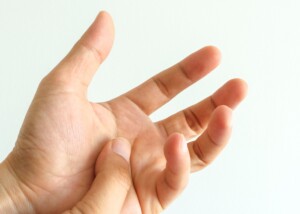Are your hands and fingers tremoring after you handled a weed snipper?
The tremoring occurs when you turn your hand so that your palm moves towards the floor.
I was using, for the first time ever, a weed snipper. It’s about two feet long and has a clipper device at the end.
You hold the handles outward, so that they form a “V.” Place the claspers on either side of the big weed’s stem, then push the handles towards each other.
This brings the claspers together, slicing the stem. This tool has some weight to it.
So I was doing this with numerous large weeds.
Not too long after, while eating, I noticed that when I turned my wrist inward (meaning, palm moving towards the floor), my hand and wrist tremored.
When I moved it in the opposite direction (palm facing upward), it stopped. This situation was present in both hands.
I thought, “What did I do today that might’ve buzzed some nerves?” I then recalled the weed trimming.
I also recalled a time when my father spent about 30 minutes struggling to cut a tough piece of meat. He just kept going and going at it.
After the dinner, when we were in the car (I was driving), he began having uncontrollable tremors in his hands and fingers. This came out of nowhere. He’d never had this issue before.
I quickly connected the dots and pointed out that his motor nerves were fatigued from all that frenetic cutting of the stubborn meat.
He was distressed because he thought that the tremoring meant a serious problem.
I said, “If you had a serious problem with the nerves that control hand and finger movement, you would NOT have been able to attack that steak for 30 minutes straight. Of course your hands and fingers are shaking: you just gave them a vigorous workout with a fork and knife!”
By later that evening the shaking had completely stopped and never returned.
One day I saw a man in the gym using the leg extension machine. Both his feet shook like mad whenever he lowered the weight. But once he stopped the set and rested, his feet stopped shaking.
By bedtime, the tremors in my hands and fingers had ceased.
My conclusion is that the very unfamiliar activity of using a weed snipping tool “buzzed” my nerves. It doesn’t matter that these same hands are used to picking up heavy barbells.
Specificity of Training Adaptation
My hands are trained to pick up heavy weights, not repetitively use a weed clipper.
Conversely, clipping weeds on a regular basis (which activates the nerves that control forearm, wrist and finger movement) will do absolutely nothing for picking up heavy barbells.
Another example of the phenomenon of training specificity is that of box jumping and walking steep hills.
A person can become highly trained at jumping repeatedly onto an 18 inch exercise stool, as well as sustaining a good walking pace up a hill.
Their body has adapted to these specific activities. But then one day they decide to jog a mile on a flat road, and find that soon, they’re winded and feel “out of shape.”
That’s because they’re untrained for this activity. Likewise, I’m untrained for repetitive or sustained weed clipping with a heavy tool. And my father was untrained for cutting at meat for 30 minutes straight.
This all isn’t to say that it’s impossible for some activities to transfer over to others.
For example, if you become well-trained with weighted squats, the deadlift and kettlebell swings, these three exercises will have major carryover to shoveling snow.
But then, shoveling snow involves joint movements that are very similar to squats, the deadlift and the kettlebell swing.
Snipping at weeds with a tool, however, involves a very different pattern of neuromuscular recruitment when compared to picking a barbell off the floor, pulling a bar towards you (seated row) or pulling a bar downward from above (lat pull-down).
Is it possible that I would’ve had hand and finger tremors had I been doing dumbbell wrist curls and wrist rolls all this time?
I’ll venture to say that I would not have had the tremors, because weighted wrist rolls (wrist extension and flexion) are sort of similar to the action of using a weed snipper.
I didn’t like the weed snipper. It was very fatiguing. So I bought a big machete and took to whacking the weeds (it’s a new home and the yard has not yet been installed). Well guess what: I didn’t have tremors after using a machete.
Why? Because the movements of using a machete for slicing and dicing weeds are similar enough to some of my gym workout movements, such that my body “recognized” them, and hence, my nerves didn’t get buzzed.
My body thought that hacking away with a machete was just another routine gym workout.
 Lorra Garrick is a former personal trainer certified by the American Council on Exercise. At Bally Total Fitness she trained clients of all ages for fat loss, muscle building, fitness and improved health.
Lorra Garrick is a former personal trainer certified by the American Council on Exercise. At Bally Total Fitness she trained clients of all ages for fat loss, muscle building, fitness and improved health.
.



























